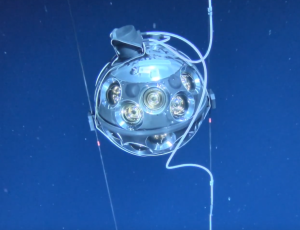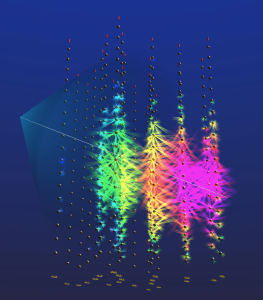KM3NeT Popular Information – 12/02/2025
Unveiling the Universe Through Ultra-High-Energy Neutrinos
When we think of the universe, images of stars, galaxies, and vast expanses of darkness come to mind. Yet, hidden within this cosmic expanse are invisible messengers—neutrinos— tiny particles that can travel unimpeded from the furthest reaches of the universe.
On the 12th of February, 2025, scientists working on the Kilometre cube Neutrino Telescope (KM3NeT) in the Mediterranean Sea have published in Nature the observation of an extraordinary event: the evidence of an ultra-high-energy cosmic neutrino, shedding new light on some of the Universe’s most energetic processes.
What are neutrinos?
Neutrinos are subatomic particles with no electric charge and an incredibly small mass. They are elusive, interacting so weakly with matter that billions of them pass through us every second without a trace. Produced in a huge range of energies, and in many different processes – from large amount of low energy neutrinos produced in nuclear fusion processes in our Sun, to small amount of high energy neutrinos coming from particle collisions in cataclysmic cosmic events such as exploding stars or black hole activity – neutrinos are unique because their path remains undisturbed . This allows them to act as cosmic messengers, carrying information directly from their astrophysical source to detectors on Earth.

Detecting neutrinos requires giant observatories for example located deep underwater or in ice. These observatories look for faint flashes of Cherenkov light—a luminous glow created when charged particles produced by neutrino interactions move faster than light in the medium. The KM3NeT telescope located deep in the Mediterranean Sea is one such observatory, designed to catch high-energy neutrino events via these flashes of light.
A record-breaking discovery
On February 13, 2023, the KM3NeT team recorded a neutrino event unlike any other. Named KM3-230213A, the neutrino’s energy was estimated to be an astonishing 220 peta- electronvolts (PeV) – roughly a billion times 100 million times the energy of visible light photons and about 30 times the highest neutrino energy previously detected.
The event occurred in KM3NeT’s ARCA detector, located 3450 meters underwater near Sicily in Italy. KM3NeT/ARCA is designed to study high-energy neutrinos, while its sister detector KM3NeT/ORCA, located near Toulon in France, focuses on lower-energy neutrinos. During this event, the detector’s photomultiplier tubes recorded over 28 000 photons of light produced while the charged particle coming from the neutrino interaction crossed the entire detector.
What makes this event special?
The detection of KM3-230213A is ground-breaking for several reasons:
- Unprecedented Energy: Such high-energy neutrinos are extremely rare, making this a monumental discovery.
- Precision Detection: The advanced design of the ARCA detector, featuring multi- photomultiplier optical modules with nanosecond timing precision, enabled precise reconstruction of the neutrino’s trajectory and energy. Its near-horizontal path through the detector indicates a cosmic origin, as atmospheric muons cannot travel such long distances through the seawater without being absorbed.
- Cosmic Origins: This neutrino might originate from a powerful cosmic accelerator, such as an active galactic nucleus or a gamma-ray burst. Alternatively, it could be a cosmogenic neutrino, produced in the interaction between an ultra-high-energy cosmic ray with the background radiation in the universe.
Searching for the source
After detecting KM3-230213A, the KM3NeT scientists analysed its direction and energy to identify its possible astrophysical origin. Researchers cross-referenced data from gamma-ray, X-ray, and radio telescopes to look for potential counterparts, such as blazars or transient events. While its arrival direction aligns with regions containing active cosmic phenomena, no definitive source could be significantly identified.

This highlights the challenge of linking single neutrino detections to specific astrophysical sources.
Its importance for neutrino astronomy
This discovery marks a milestone in neutrino astronomy, a field still in its infancy compared to traditional optical or radio astronomy. High-energy neutrino observations like KM3- 230213A offer unique insights into the most extreme environments in the universe. They may help answer long-standing questions about the origins of cosmic rays and how they can be accelerated to such enormous energies.
Furthermore, KM3-230213A provides valuable data to refine models of cosmic neutrino production and propagation. It also demonstrates the capabilities of next-generation observatories like KM3NeT, which continue to push the boundaries of our understanding.
The road ahead
While KM3-230213A raises many questions, it also opens new doors. Future observations will focus on detecting more such events to build a clearer picture of their origins. The ongoing expansion of KM3NeT with additional detection lines and increasing data taking time will improve its sensitivity and enhance its ability to pinpoint neutrino sources.
The evidence of this ultra-high-energy cosmic neutrino is a testament to human ingenuity and the enduring quest to understand the universe. Each neutrino captured is like a piece of a jigsaw puzzle, revealing a bit more about the cosmos. As technology advances, we are poised to discover even more extraordinary phenomena in the vast expanse of space.

